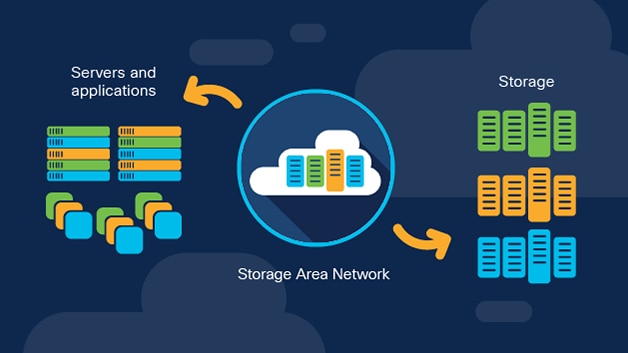Why are SANs essential to today's businesses?
SAN storage has been around for many years. But several factors are making this network-based storage solution more important than ever for everyday business use. For example:
- Organizations need to provide users reliable access to data at all times.
- Data of all types, structured and unstructured, is growing exponentially.
- Cloud computing, digitization, and other IT trends are placing higher demands on the technology used to manage, transport, back up, and restore data.
Also, organizations have more diverse application environments, and they want to avoid storage access issues that can undermine application performance.
Growing adoption of new technologies to support newer app environments — such as high-performance storage systems with Non-Volatile Memory Express (NVMe) — is also placing pressure on storage networks.
Many organizations are also more focused on disaster recovery and business continuity today and want to consolidate data into a SAN network to make data replication easier.
In short, organizations need to ensure the SAN they rely on to accelerate their access to data and support increasing application workload availability and performance requirements is modern and designed to meet new challenges.
What is SAN fabric?
SANs provide any-to-any connectivity for servers and storage devices using Fibre Channel (FC) switches that are compatible with the FC protocol. FC SAN switches are used to connect devices within a SAN to create the SAN fabric.
Routers, gateway devices, and cables that help the SAN interconnect servers with storage devices are also part of SAN fabric. IT teams can use fabric layer elements to optimize the performance, scalability, and availability of the SAN for the business and its users.
There are two additional layers in the SAN that are not part of the SAN fabric:
- The host layer, which is comprised of the servers that attach to the SAN to access data from storage devices to support application and database workloads
- And the storage layer, which includes all the storage resources that the SAN brings together into one network, including disk arrays, tape arrays, flash solid-state drives, RAID arrays, and more.
How do SAN and NAS differ?
A SAN and network-attached storage (NAS) are both network-based storage solutions; however, a SAN is more complex.
A SAN is a network that operates independently of an organization's operating system and is comprised of many different storage devices. It uses FC switches and stores data at the block level. To a client operating system, the SAN typically appears as a disk.
A NAS device, or NAS unit, connects to a local-area network (LAN) through an Ethernet connection to provide file-based data storage services to other devices on the network. To a client operating system, a NAS device appears as a file server.
While NAS also takes storage devices away from the server to create a central pool of data, NAS storage connects directly to the LAN. In SAN storage, capacity is pooled and provided with a dedicated network.
Is modernizing a SAN disruptive?
It doesn't have to be. If an organization already has the right SAN infrastructure in place, it can work with a leading provider of SAN technology to modernize its storage area network seamlessly and quickly, and without a major equipment upgrade.
The business can also invest in today's SAN technology that can evolve to keep up with increasing application workload availability and performance requirements. That can help the business avoid forklift upgrades for its SAN infrastructure in the future as needs change.
